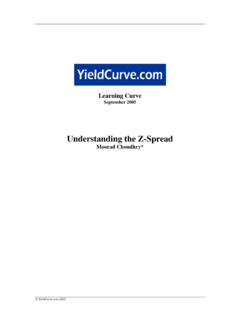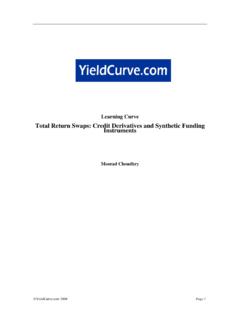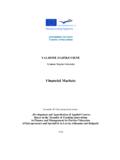Transcription of Learning Curve Forward Rate Agreements - …
1 Learning Curve Forward Rate Agreements Anuk Teasdale 2004 Page 1 In this article we review the Forward rate agreement . Money market derivatives are priced on the basis of the Forward rate, and are flexible instruments for hedging against or speculating on Forward interest rates . The FRA and the exchange-traded interest rate future both date from around the same time, and although initially developed to hedge Forward interest rate exposure, they now have a variety of uses.
2 In this article the FRA is introduced and analysed, and we review its main uses. Forward rate Agreements A Forward rate agreement (FRA) is an OTC derivative instrument that trades as part of the money markets. It is essentially a Forward -starting loan, but with no exchange of principal, so that only the difference in interest rates is traded. An FRA is a Forward -dated loan, dealt at a fixed rate, but with no exchange of principal only the interest applicable on the notional amount between the rate dealt and the actual rate prevailing at the time of settlement changes hands.
3 So FRAs are off-balance sheet (OBS) instruments. By trading today at an interest rate that is effective at some point in the future, FRAs enable banks and corporates to hedge interest rate exposure. They may also be used to speculate on the level of future interest rates . Definition An FRA is an agreement to borrow or lend a notional cash sum for a period of time lasting up to twelve months, starting at any point over the next twelve months, at an agreed rate of interest (the FRA rate). The buyer of an FRA is borrowing a notional sum of money while the seller is lending this cash sum.
4 Note how this differs from all other money market instruments. In the cash market, the party buying a CD or bill, or bidding for stock in the repo market, is the lender of funds. In the FRA market, to buy is to borrow . Of course, we use the term notional because with an FRA no borrowing or lending of cash actually takes place, as it is an off-balance sheet product. The notional sum is simply the amount on which interest payment is calculated. So when an FRA is traded, the buyer is borrowing (and the seller is lending) a specified notional sum at a fixed rate of interest for a specified period, the loan to commence at an agreed date in the future.
5 The buyer is the notional borrower, and so if there is a rise in interest rates between the date that the FRA is traded and the date that the FRA comes into effect, she will be protected. If there is a fall in interest rates , the buyer must pay the difference between the rate at which the FRA was traded and the actual rate, as a percentage of the notional sum. The buyer may be using the FRA to hedge an actual exposure, that is an actual borrowing of money, or simply speculating on a rise in interest rates .
6 The counterparty to the transaction, the seller of the FRA, is the notional lender of funds, and has fixed the rate for lending funds. If there is a fall in interest rates the seller will gain, and if there is a rise in rates the seller will pay. Again, the seller may have an actual loan of cash to hedge or be a speculator. 2004 Page 2 In FRA trading only the payment that arises as a result of the difference in interest rates changes hands. There is no exchange of cash at the time of the trade. The cash payment that does arise is the difference in interest rates between that at which the FRA was traded and the actual rate prevailing when the FRA matures, as a percentage of the notional amount.
7 FRAs are traded by both banks and corporates and between banks. The FRA market is very liquid in all major currencies and rates are readily quoted on screens by both banks and brokers. Dealing is over the telephone or over a dealing system such as Reuters. The terminology quoting FRAs refers to the borrowing time period and the time at which the FRA comes into effect (or matures). Hence if a buyer of an FRA wished to hedge against a rise in rates to cover a three-month loan starting in three months time, she would transact a three-against-six month FRA, or more usually a 3 6 or 3-v-6 FRA.
8 This is referred to in the market as a threes-sixes FRA, and means a three-month loan beginning in three months time. So a ones-fours FRA (1-v-4) is a three-month loan in one month s time, and a threes-nines FRA (3-v-9) is six-month money in three months time. Note that when one buys an FRA one is borrowing funds. This differs from cash products such as CD or repo, as well as interest rate futures, where buying is lending funds. Example 1 A company knows that it will need to borrow 1 million in three months time for a twelve-month period.
9 It can borrow funds today at LIBOR + 50 basis points. LIBOR rates today are at 5% but the company s treasurer expects rates to go up to about 6% over the next few weeks. So the company will be forced to borrow at higher rates unless some sort of hedge is transacted to protect the borrowing requirement. The treasurer decides to buy a 3-v-15 ( threes-fifteens ) FRA to cover the twelve-month period beginning three months from now. A bank quotes 5 % for the FRA which the company buys for a notional 1 million. Three months from now rates have indeed gone up to 6%, so the treasurer must borrow funds at 6 % (the LIBOR rate plus spread), however she will receive a settlement amount which will be the difference between the rate at which the FRA was bought and today s twelve-month LIBOR rate (6%) as a percentage of 1 million, which will compensate for some of the increased borrowing costs.
10 2004 Page 3 FRA mechanics In virtually every market worldwide, FRAs trade under a set of terms and conventions that are identical. The British Bankers Association (BBA) has compiled standard legal documentation to cover FRA trading. The following standard terms are used in the market. Notional sum: The amount for which the FRA is traded. Trade date: The date on which the FRA is dealt. Settlement date: The date on which the notional loan or deposit of funds becomes effective, that is, is said to begin.










